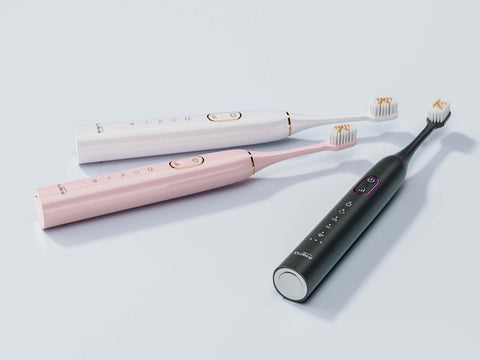
La enfermedad de las encías, también conocida como enfermedad periodontal, es una afección común y prevenible que afecta a millones de personas en todo el mundo. Varía desde una simple inflamación de las encías, conocida como gingivitis, hasta infecciones más graves que dañan el tejido blando y el hueso que sostiene los dientes. Entre las diversas medidas preventivas, los cepillos de dientes eléctricos han surgido como una herramienta crucial en la lucha contra la enfermedad de las encías. Este artículo explora cómo los cepillos de dientes eléctricos pueden mejorar significativamente la salud de las encías y prevenir la progresión de la enfermedad periodontal.
Eliminación superior de placa
Los cepillos de dientes eléctricos están diseñados para moverse a alta velocidad en movimientos oscilatorios o vibratorios, lo que proporciona una eliminación de placa superior en comparación con los cepillos de dientes manuales. La eficacia de los cepillos de dientes eléctricos para eliminar la placa y reducir la gingivitis está bien documentada en numerosos estudios dentales. La placa es una película pegajosa de bacterias y partículas de comida que puede endurecerse y convertirse en sarro si no se elimina con regularidad. Dado que la formación de sarro a lo largo de la línea de las encías es un factor clave para la enfermedad de las encías, la capacidad de los cepillos de dientes eléctricos para limpiar eficazmente a lo largo y por debajo de la línea de las encías es vital.
Presión y técnica constantes
Una de las principales ventajas de los cepillos de dientes eléctricos es su capacidad para proporcionar una presión y una técnica de cepillado constantes. Muchos modelos vienen equipados con sensores de presión que alertan al usuario si se está aplicando demasiada fuerza. Una presión excesiva puede provocar recesiones y abrasión de las encías, que son factores de riesgo de enfermedades de las encías. Además, los cepillos de dientes eléctricos suelen incluir temporizadores para garantizar que los usuarios se cepillen durante los dos minutos completos recomendados por los dentistas, lo que mejora aún más su eficacia para mantener la salud bucal.
Cabezales de cepillo especializados
Muchos modelos de cepillos de dientes eléctricos ofrecen cabezales de cepillo especializados diseñados para mejorar la salud de las encías. Por ejemplo, algunos cabezales de cepillo están diseñados específicamente para encías sensibles, mientras que otros cuentan con cerdas suaves que son delicadas con las encías pero efectivas para limpiar los dientes. Estos cabezales de cepillo especializados pueden llegar a las zonas difíciles alrededor de los dientes y las encías donde las bacterias suelen acumularse, lo que reduce las posibilidades de problemas periodontales.
Ideal para pacientes con aparatos de ortodoncia
Los pacientes con aparatos de ortodoncia u otros aparatos son especialmente susceptibles a las enfermedades de las encías, ya que sus aparatos dentales pueden atrapar partículas de comida y bacterias, lo que dificulta la limpieza eficaz. Los cepillos de dientes eléctricos pueden maniobrar alrededor de los aparatos y limpiar de forma más eficaz que los cepillos de dientes manuales. Esto no solo ayuda a prevenir las enfermedades de las encías, sino que también mantiene la higiene bucal general, que es crucial durante los tratamientos de ortodoncia.
Fomentar el uso regular
La facilidad de uso y la eficiencia de los cepillos de dientes eléctricos fomentan su uso regular, lo cual es fundamental para prevenir enfermedades de las encías. Es más probable que las personas sigan una rutina de higiene bucal simple y efectiva. Las atractivas características de los cepillos de dientes eléctricos, como la conectividad Bluetooth que puede proporcionar información en tiempo real a través de aplicaciones para teléfonos inteligentes, agregan un elemento de interactividad al cepillado que puede motivar a los usuarios, en particular a los adultos jóvenes y los niños, a cepillarse los dientes de manera regular y correcta.
Conclusión
En conclusión, los cepillos de dientes eléctricos ofrecen varias ventajas significativas sobre los cepillos de dientes manuales, especialmente cuando se trata de prevenir y controlar las enfermedades de las encías. Su capacidad de limpieza superior, la técnica de cepillado constante, los cabezales de cepillo especializados y las características de fácil uso los convierten en una herramienta esencial para mantener la salud de las encías. Para cualquier persona que busque mejorar su rutina de higiene bucal, invertir en un cepillo de dientes eléctrico podría ser un paso hacia unas encías más sanas y una vida más saludable. Las visitas regulares al dentista y los buenos hábitos de cepillado, con la ayuda de la tecnología de un cepillo de dientes eléctrico, son estrategias clave en la lucha contra las enfermedades de las encías.








